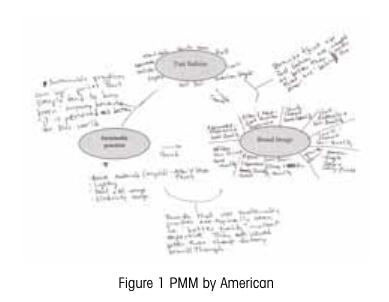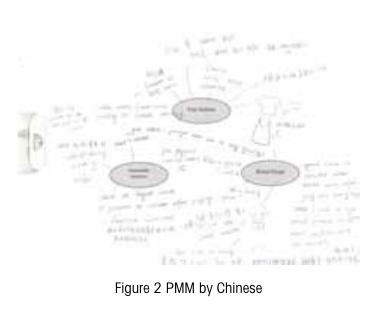Fashion brands and sustainable practices:Differences between American and Chinese consumers
2016-05-14



By use of the research method of Personal Mind Mapping (PMM), this research investigates the differences between American and Chinese evaluations of fast fashion regarding sustainable practices. The research results show there exist distinct differences. The opinions of American consumers are widely divergent but only confine to American and European brands. On the other hand, the opinions of Chinese consumers are more consistent and involve Asian brands as well.
The American and Chinese consumers both have almost the same brand images of fast fashion except for the more consistency of Chinese consumersopinions. The Americans mention more of sustainable practices beyond the environmental area, which shows that they are better educated in the sense of sustainability than Chinese.
Typically, American participants view the relationship between fast fashion and sustainable practices as uncorrelated or that participating in sustainable practices makes fast fashion ‘green and desirable. Whilst, most Chinese participants think that being sustainable is difficult nowadays, but it will be a good strategy for fast fashion. Most of the American participants believe that fast fashion has a good brand image because it means keeping up with the trend. However, most of the Chinese participants consider that fast fashion can only catch peoples eyes for a short period of time, and that brands tagged with fast fashion have a worse brand image. Both American and Chinese participants think that sustainable practices will improve a brands image.
Introduction
Fast fashion has appeared in the apparel market since the end of the last century. Unlike the traditional model of haute couture and ready-to-wear mass production, fast fashion allows people to catch up with new trends and colors with affordable prices. The Spanish brand Zara, an exemplar of fast fashion retailing, has been one of the fastest growing fashion companies in the world, pioneering in providing new seasonal trends at lower prices (Joy, 2013).
To some extent, because of its affordability, and usually not very good quality, fast fashion is seen as disposable fashion (Textile US EPA). Therefore, it can be easily given up or even thrown away by consumers. It was estimated that 14.3 million tons of textile waste was generated in 2012, making up about 5.7% of the total municipal solid waste in USA, and only 15.7% of the textile waste was recycled in USA (Textile US EPA). While in China, it was estimated that more than 24 million tons of textile waste was produced in 2012, and only about 3% was recycled or reused; most of the textile waste went to the landfills (Bai, 2013).
The recovery rate of textiles in China is far lower than that of the USA. Cacioppo and Pettys (1982) research implies that cognitively viewing something as cheap makes it easier to be thrown away. Therefore, significant differences on fast fashion brands regarding sustainable practices between American and Chinese consumers may indirectly lead to the lower recovery rate of textiles in China. This paper tries to answer this question.
Literature review
Fast fashion
Fast fashion is a contemporary term used by fashion retailers to describe designs that move from catwalk to store in the fastest time to capture current trends in the market (Hines & Bruce, 2001). With both enhanced design and rapid production, benefited by equilibrium inventory levels and relatively lower prices, fast fashion introduces new styles into stores every few weeks, quickly inspired by runway or high-end labels or magazines (Cachon &Swinney, 2009, Fletcher, 2010, Bhardwaj & Fairhurst, 2010). For example some companies can turn around new styles from design to store within two weeks (Tiplady, 2006).
Fast fashion provides affordable apparel aimed mostly at young women(Claudio, 2007), aged 12 - 17. There are more females in the ‘innovators and ‘early adopters categories and more males in the ‘late majority and ‘laggards categories (Beaudoin et al., 2003). ‘Innovatorsand ‘early adopters are highly conscious of fashion and aware of new trends. ‘Late majority consumers are interested in new trends but less inclined to adopt them very quickly; ‘laggards care about fashion trends but will adopt the trend only after all others take the trends (Rogers 1983). Fashion magazines help to create the desire for new clothing. Girls tend to be insatiable when it comes to clothing. In the traditional fashion buying cycle, customers buy clothes seasonally or buy when needed. The fast fashion customers, mainly young girls, buy clothes frequently, even on a weekly basis (Bruce and Daly, 2006). For example, Zara has an informal policy of moving unsold items after two or three weeks (Ferdows et al., 2005), which means if one doesnt buy right now, she/he cannot buy it later. This in turn, pushes people to buy clothes impulsively, which may easily lead to overconsumption. Also, because fast fashion clothes are relatively cheap, people buy more and dispose more (Claudio, 2007).
Brands such as H&M and Zara have managed to respond to this demand by constantly “refreshing” their product range (Christopher et al., 2004; Frings, 2002). Some fast fashion companies keep trendy by carefully monitoring consumers and industry tastes for unexpected fads and reducing design lead time. For example, the Italian fashion company Benetton employs a network of “trend-spotters”and designers throughout Europe and Asia, and also pays close attention to seasonal fashion shows in Europe (Meichtry, 2007).
Fast fashion companies try to keep trendy, while maintaining affordability for anyone wishing to follow the latest trends. Fast and affordable prices require the companies to use mediocre textiles and craftsmanship. Some fast fashion retailers designs are made to be worn less than 10 times (McAfee et al., 2004), which results in more textile waste (Morgan & Birtwistle, 2009).
Brand image
Keller (1993) defined brand image as“perceptions about a brand as reflected by the brand associations held in memory”. The brand image is a consumer-driven concept influenced by company efforts and developed from a variety of sources, including brand and product attributes, price information, positioning in promotional communications, packaging, user imagery (e.g., typical brand users), and usage occasion (Keller, 1993).
Companies have focused on providing functional benefits such as affordable prices or higher fashions to achieve customer preferences for one brand over others, which means a good brand image for their goods or service. Classical segmentation-targeting-positioning approach(Aaker, 1997; Freling & Forbes, 2005) suggests that each brand should have its unique and distinct personality to serve its target market segment. Contrary to this traditional approach, based on a sample of 571 questionnaires using cluster analysis, Ivens and Valta (2012) proved that customers perceive brands differently, so it is difficult for companies to segment, target and position their goods and services.
Brand images may also vary across countries. The research on cultural values(Hofstede, 2003) suggests that different country populations differ in their value systems. For example, American society is known for emphasizing individualism more than Chinese society does. Therefore, brands that help consumers express themselves and distinguish themselves from other people may be more attractive to American customers than to Chinese customers.
Sustainable practices
Sustainable development has been defined as human progress that meets the present social, economic and environmental objectives without compromising the ability of future generations to meet their needs (Burton, 1987).
Many industries have done a lot to become more sustainable. By improving the efficiency of supply chains, the dairy industries reduce the amount of energy they use (Glover et al., 2014). Construction can become greener by emitting less greenhouse gases and using less natural resources (Robichaud & Anantatmula, 2011). New technologies have been introduced into the textile industry in order to reduce its impact on the environment(Chen & Burns, 2006).
Consumers can also participate in sustainable practices by using energy and resources in more responsible ways. This could mean buying a house with energy efficient features or buying an apartment that has been renovated by using non-toxic and/or recycled/salvaged materials. Both are examples of using resources in more responsible ways. One of these examples addresses the problem of the growing scarcity of the resources that people currently use (water, energy, clean air, food, raw materials) and the other addresses the problem of improving the quality of air and drinking water. Both of these practices will result in a planet that is able to support life well into the future (What does Sustainable Practices mean?).
Methodology
Originated by Tony Bouzan of the Learning Methods Groups in England(Buzan, 1993), mind mapping uses the diagramming of ideas and concepts to help streamline thought processes and organize information (Burnham 2009). Crowe and Sheppard (2011) provide an example of how to use mind mapping in explaining seven distinct research areas, and suggest that mind maps may help to produce more robust research. Gaimster(2011) believes mind mapping can be a useful research method for the fashion industry. Personal mind mapping (PMM) is a recently developed data collection technique “designed to measure how a specific learning experience uniquely affects each individuals understanding or meaning-making process” (Adam et al., 2003).
The purpose of this paper is to explore the differences between American and Chinese consumers evaluation of fast fashion brands in terms of sustainable practices. The PMM method and supplemental interviews are used for data collection.
Research process
Each participant of this research was given a sheet of paper, on which there were 3 circles. Inside the circles were Fast fashion, Brand image and Sustainable practices. Along with the PMM paper, the participant was given instructions, including some brainstorming questions, such as What brand names can you think of that represent fast fashion? What is your perception of the brand image, sustainable practices and fast fashion of the fashion companies or brands you have listed? What types of relationships exist among these aspects of fashion business? Also, some pictures from other research were shown to the participant so as to help express her/his ideas.
Young females are more likely to buy fast fashion clothing (Claudio, 2007), therefore the researchers mainly recruited females as participants. The researchers first identified the nationalities of the participants, and then asked them to write down their thoughts. Usually it took 10 minutes to finish the writing. Then, the researchers would see what the participants have written. Two PMM results are shown as figure 1 and 2.
Data analysis
A sample of 42 participants was conveniently recruited for the study. There were 21 American and 21 Chinese consumers. The results are as follows.
Demographic data
As figure 3 shows, more than 70% of American participants are aged from 21 to 25, and the rest are from 15 to 20 years old. Figure 4 shows that 38% of the Chinese participants are aged from 15 to 20 years old or from 21 to 25 years old. Nearly 20% of the Chinese participants are older than 31, and only 5% are aged between 26 and30. In terms of gender, there is only one male among the 21 American participants, and 3 males among the 21 Chinese participants. The demographic difference between American and Chinese participants may have some impact on the research results.
Fast fashion brands mentioned
The results show that there are distinct differences between American and Chinese consumers when asked to evaluate fast fashion brands in terms of sustainable practices. The American consumers mentioned 76 brands, while the Chinese consumers mentioned 64 brands.
Table 1 displays the top 10 brands mentioned by American and Chinese participants, which shows that the brands mentioned by Chinese consumers are more consistent than those mentioned by American consumers. In addition, there was a difference in the mentioning frequency. 17 Chinese participants mentioned H&M, while it was only mentioned by 7 Americans. Zara, the well recognized and fastest growing global fast fashion brand, was mentioned by only 2 Americans, while mentioned by 10 Chinese participants.
In total, only 30 brands were mentioned by both American and Chinese participants, accounting for less than half of the total number of brands mentioned by each group. Eight famous store brands which are not related to apparel, but may sell some self-branded apparel, such as Macys, JC Penny, and Walmart were mentioned by American participants. One participant mentioned McDonalds as a representative of fast food, and another mentioned Chanel as a representative of luxury brands.
Three famous IT brands, Google, Microsoft and Apple were mentioned by Chinese consumers because the participants believed these IT brands represented fast fashion too. Monsanto was mentioned by a Chinese male consumer because he believed that Monsanto represented the future of agriculture and was designed for the fast changing society.
Chinese participants also mentioned the famous Japanese fast fashion brand, Uniqlo, and some European brands, such as C&A, Vero Moda, and Only, while American consumers mostly mentioned brands from the USA, and several European brands, including the luxury brand Channel.
Brand Image
As is shown in Figures5 and 6, American participants evaluated fast fashion as something cheap, fashionable, nice looking, young, classy, cute and various, durable, and comfortable and often of high quality. However, a few Americans thought that fast fashion was expensive. Chinese participants regarded fast fashion as cheap, fashionable, affordable, and of good quality though the same amount of Chinese consumers thought of‘low or bad quality. The Chinese participants also thought that the fast fashions were young, various, sporty, up-to-date, expensive, professional, and girly.
As is shown in Table 2, images of some brands are given by both American and Chinese participants.
It can be found that the American and Chinese participants had almost the same impressions for most of the brands, except H&M. American consumers thought it was expensive, but Chinese consumers held the opposite opinion. In addition, when it came to the quality of H&Ms clothing, the Chinese consumers opinions were detrimentally different from those of the American consumers. It should be pointed out that Gap was regarded by the American consumers as sustainable in terms of its material source and production methods. However, Chinese participants only had some impressions about its design, price and quality, but nothing related to social sustainability.
Sustainable Practices
American participants mentioned 24 kinds of sustainable practices which were not limited to the fashion industry but included areas such as society, environment, and economy, as well as healthy living, employees wages/ benefits, production location and trade fairness. Chinese consumers, on the other hand, mentioned 26 kinds of sustainable practices, and the concepts were mentioned with a higher frequency and mostly could be categorized in sustainable environmental practices, without any connection with social practices. The sustainable practices frequently mentioned by American and Chinese participants are illustrated in Figure 7.
The American and Chinese consumers provided slightly different sustainable practices. Sustainable practices frequently mentioned by American participants were recycling, reusing, Goodwill, green material processing, less energy usage, donation, cotton production, hand-me-down, and multipurpose clothes. On the other hand, sustainable practices frequently mentioned by Chinese participants were donation, hand-me-down, recycling, water reusing, reusing, color resistent dying, wearing second hand clothes, twoside use of paper and exchanging clothes. Though there were just small differences between the sustainable practices provided by American and Chinese participants, it can be seen that sustainable practices were provided more specifically by the American participants.
Relationship between Fast Fashion and Sustainable Practices
Typically, American participants viewed the relationship between fast fashion and sustainable practices as uncorrelated or that participating in sustainable practices made fast fashion ‘green and desirable. They also believed that being sustainable meant social or environmental sustainability.
One American participant (A25) thought that “fast fashion and sustainable practices do not correlate since usually fast fashion is not sustainable”. Even the other participant (A6) thought that “fast fashion has a bad reputation for not being sustainable because people dont recycle their clothes; and consumers are buying more and more which creates more waste and pollution.”
Some American participants thought that implementing sustainable practices would make fast fashion appear to be green and desirable. One American participant (A15) believed that “fast fashion is taking an increasingly active part in sustainable practices”. Another participant(A5) said, “sustainable practices can be expensive, but people tend to buy ‘greenthings anyway because it is perceived as better for our world.” Furthermore, another participant (A29) said, “more advertising of the company being ‘green will attract more people to shop there”.
Some other American participants claimed that if fast fashion wanted to participate in sustainable practices, it should pay more attention to environmental and social responsibilities. One American participant (A2) said that “fast fashion will be popular and do things well, for example caring about the environment will help even more”. The other participant(A26) thought that “to be sustainable fast fashion should pay its workers fairly and be environmentally responsible”.
Whilst, most of the Chinese participants thought that being sustainable is difficult, but it would be a good strategy for fast fashion.
Some Chinese participants just considered that in general it was difficult to keep sustainable. One participant (C1) believed that “it is not easy to keep sustainable (efficiency, quality for each piece of products)”. Another participant (C14) held that “it will be hard to implement sustainable practices in fast fashion industry in recent years”.
One Chinese participant (C6) particularly pointed out that fast fashion was not sustainable and that fast fashion should not be sustainable. She wrote that “due to the nature of fast fashion, it aims to provide the aesthetic value through rapidly mimic the high-end fashion brands. Consumers tend to buy and discard them quickly to stay with trends. The fast fashion brands are usually non-sustainable. They dont use local materials or local labors. The fast-changing trends also require them to get non-environmental techniques in fabrication and manufacturing”.
Some Chinese participants thought that implementing sustainable practices would be a good strategy. One Chinese participant (C30) thought that “fast fashion is cheap, so the clothes may be recycled, and this is a kind of sustainable practice. Nike does this so it can dominate the running and basketball shoes market”.
Relationship between Fast Fashion and Brand Image
Most of the American participants thought that fast fashion had a good brand image because it implied keeping up with the trend. One participant (A5) thought that “brands considered as ‘fast fashionare better than those that are ‘outdated”. One participant (A30) believed that “fast fashion captures styles from the runway quickly into the stores, which makes and maintains their brands up-to-date”. Another participant (A24) considered that“fashion trend is short and there are many different trends contemporarily, so consumers want to buy more”. Also another participant (A12) wrote that “fast fashion has a more popular brand image. People like the quality and style of fast fashion”.
Besides that, the American participants also believed that a good brand image would help a brand to be popular. One participant (A2) thought that “a good image will help brands become popular fast”. Another participant (A25) thought that “image sells the fast fashion”.
On the other hand, most of the Chinese participants considered that fast fashion could catch peoples eyes, but only for a short period of time, and brands tagged with fast fashion had a lower brand image.
One participant (C15) held that“fast fashion can be eye-catching and be popular among young people, but in the long term, it cant have the brand image of a high fashion brand which can be remembered forever”. Another participant(C30) thought that “fast fashion can make some brands successful, but it certainly cannot sustain a brand”. Two participants(C1 & C2) believed that “fast fashion attracts customers to keep their eyes on the brands clothing, and has the ability to refresh styles quickly”. Another two participants (C22 &C24) wrote that “fast fashion lowers brand image because fast fashion aims at the majority in order to attract as many customers as possible”.
Relationship between Sustainable Practices and Brand Image
Both American and Chinese participants thought that sustainable practices would improve a brands image.
One American participant (C30) thought that “sustainable practices give the brand a certain brand images”. Two participants (C24 & C29) thought that “sustainable practices enhance brand image”.
Meanwhile, one Chinese participant(A5) believed that “brands that implement sustainable practices are typically regarded as ‘with better quality. Albeit expensive, they are rated better than cheap factory brands”. The other Chinese participant (A9) thought that “sustainable practices are conducive to a better brand image”. Another Chinese participant(A29) thought that “sustainable practices improve brand image”.
Conclusion and Discussion
This research shows that there are distinct differences between American and Chinese consumers when asked for their evaluation of fast fashion brands as it relates to sustainable practices. The American consumers have mentioned 76 brands, while the Chinese consumers have mentioned 64 brands with high frequency. It means that Chinese consumers opinions about fast fashion are more consistent than that of American consumers.
Both American and Chinese consumers evaluate fast fashion as cheap, fashionable, young, high-quality and stylish. But the frequency is different, which also confirms that Chinese participantsopinions are more consistent than that of American participants.
American participants have mentioned 24 kinds of sustainable practices which are not limited to the environmental area but include social, and economic sustainable practices; on the other hand, Chinese participants have mentioned 26 kinds of sustainable practices, but are limited to the environmental area. It can be noticed that American participants will think of social sustainability when asked about sustainable practices while Chinese participants only think of sustainable environmental practices, which may be because the American consumers are better educated in sustainability than Chinese consumers.
Though American participants consider that fast fashion is not sustainable and produces more waste, they do believe that brands tagged with fast fashion will be better than those which are out of date, and that good brand images will sell fast fashion. Fast fashion should pay more attention to both environmental and social responsibility, and only in this way will consumers deem fast fashion as desirable. On the other hand, Chinese participants believe that in general it is difficult to maintain sustainability, but also that being sustainable can be a good strategy for fast fashion. Meanwhile, Chinese participants think that fast fashion can be eye-catching, but cannot last for long. Both American and Chinese participants believe that sustainable practices will improve the image of a brand.
This research is based on a convenient sample of 21 American and 21 Chinese participants. Most of the Chinese participants and all the American participants are the students of University of Missouri, which may lead to biased results. Besides that, although the research is a comparison between Americans and Chinese, all the participants are living in the USA, which may amplify the deviation. Considering the cultural differences, recruiting more participants from a wider age range and native American and Chinese may give us more distinct differences, which would be an interesting research area.
杂志排行
China Textile的其它文章
- Dear readers
- Moving Toward Sustainability in the Cotton Supply Chain
- Fifth ITMA ASIA+CITME exhibition over 90 per cent sold at close of space application period
- Cotton Market Fundamentals & Price Outlook
- Mercedes-Benz China Fashion Week:“Design +”unveils a new future
- Sustainable metallising textile production developed in Hong Kong POLYU
